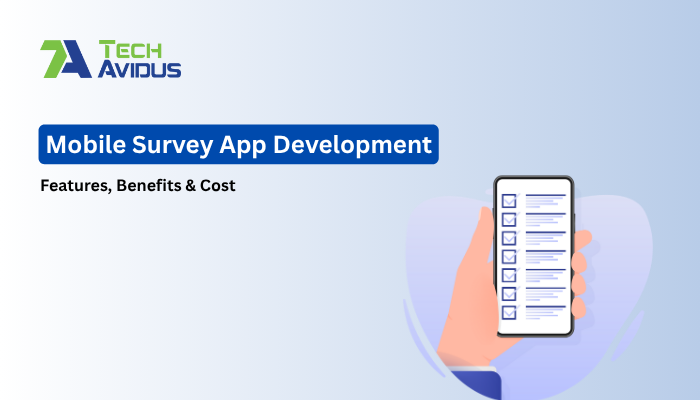
In today’s data-driven world, the way surveys are conducted is undergoing a seismic shift. Gone are the days of clipboards, spreadsheets, and clunky online forms. Survey mobile app developments are revolutionizing how organizations—from NGOs to research firms and healthcare providers—gather real-time, reliable insights.
Whether you need offline data collection in rural areas or instant customer feedback in urban settings, mobile survey apps provide speed, accuracy, and accessibility that traditional methods simply can’t match.
Mobile survey app development refers to the process of building a custom software solution that enables organizations to create, distribute, and analyze surveys directly through smartphones or tablets.
Unlike basic tools like Google Forms or SurveyMonkey, these apps can be tailored for:
They’re especially valuable in industries where field research, feedback, or large-scale data collection is critical.
Organizations today face multiple challenges with traditional or web-only surveys:
A mobile-first approach solves this by putting survey tools in users’ pockets.
📌 According to Statista, over 90% of internet users globally access the web via mobile devices. That’s your audience—right there.
Example:
An NGO working in the tribal areas of Northeast India used a mobile survey app with offline support. Field workers could collect responses without internet, which synced automatically once they returned to a connected zone.
Here’s why organizations are turning to custom survey apps:
Apps can function without internet access—perfect for rural, disaster-hit, or low-connectivity zones.
Real-time syncing with central databases allows faster analysis, especially in time-sensitive missions like healthcare or political surveys.
Built-in validation checks reduce human error. GPS, camera, and timestamps enhance data reliability.
You can customize UI/UX, add your logo, and configure logic flows tailored to your goals—unlike rigid tools like Google Forms.
Mobile apps allow for encrypted data collection, user access control, and audit trails, which are essential for sectors like healthcare or finance.
To be truly effective, a survey app must be built with real-world use in mind. Here’s what to include:
⚠️ If you're using Google Forms for large-scale or conditional surveys, you’ll find these features lacking, especially when offline mode or secure data capture is essential.

User adoption is everything. A clunky survey app can lead to poor engagement and low-quality data. Here's how to enhance the experience:
Use Case:
We helped develop a healthcare feedback collection app that used simple iconography, progress bars, and native input controls. This led to a 40% increase in completion rate compared to their old form-based system.
While there’s an upfront investment in development, the long-term savings are significant:
Plus, apps offer reusability—a survey format can be cloned and deployed multiple times with minor tweaks.
Interested in cost estimation? We offer a free consultation to help assess your needs and provide a tailored quote.
From AI-driven sentiment analysis to voice-input surveys, the evolution of survey mobile app developments is accelerating. Organizations that adopt mobile survey strategies today are future-proofing their data collection workflows.
Expect to see:
Whether you’re an NGO, research agency, or enterprise, mobile survey apps are no longer optional—they’re essential. Need a Custom Survey App for Field Data Collection? Get a free consultation from our mobile development experts.
1. Can survey apps work without internet?
Yes. Offline mode enables data collection without a network. Data syncs once connected.
2. Why not use Google Forms for large-scale surveys?
Google Forms lacks offline mode, advanced logic, secure access control, and is not ideal for mobile-heavy users.
3. How to prevent fake or duplicate responses?
You can use device fingerprinting, OTP validation, GPS logging, and session timeouts.
4. Can we build a survey app for our NGO’s fieldwork?
Absolutely. We’ve helped NGOs build multilingual, offline-first apps tailored for low-literacy, rural environments.
5. Is multilingual survey creation possible?
Yes, modern survey apps support multiple languages with switchable UI and dynamic question rendering.
6. Can I collect customer feedback in real-time via mobile?
Yes. You can set up kiosk mode apps or in-app surveys that sync data instantly to dashboards.
7. What tech stack is best for mobile survey apps?
We recommend Flutter or React Native for cross-platform apps, Firebase or AWS for backend, and integration with tools like Power BI or Tableau for reporting.
8. Can we use AI in survey apps?
Yes. AI can be used for open-text response analysis, fraud detection, and predictive insights.
9. How much does a survey app cost to build?
It depends on scope, features, and platforms. Contact us for a free consultation to get a ballpark estimate.
Bhavesh Tarkhala is a Business Consultant at TechAvidus with 9+ years of experience turning complex survey models into scalable, user-friendly platforms. He supports leadership and research firms with 360° feedback, DEI tools, and pulse surveys—guiding tech choices, compliance, and analytics to drive meaningful insights and impact.
Our Top 1% Tech Talent integrates cutting-edge AI technologies to craft intelligent, scalable, and future-ready solutions.
All Rights Reserved. Copyright © 2025 | TechAvidus